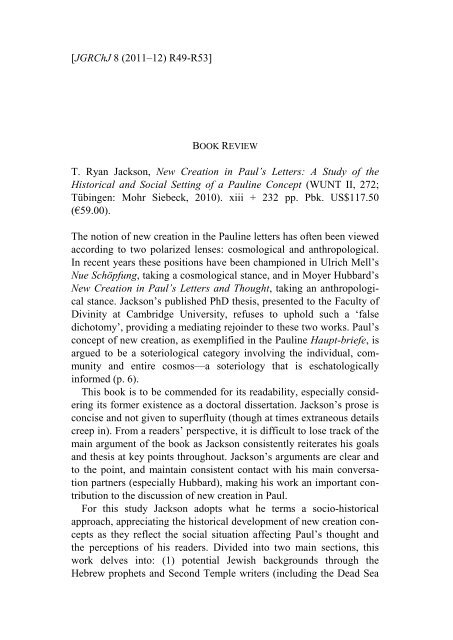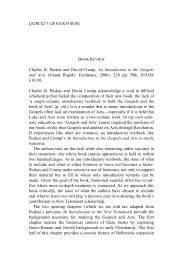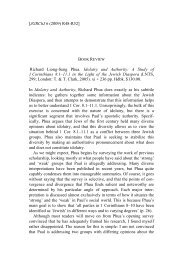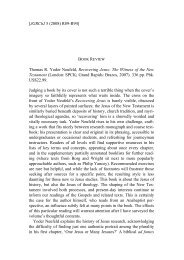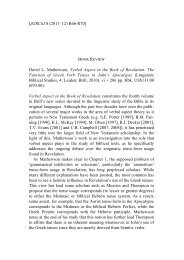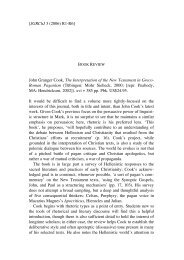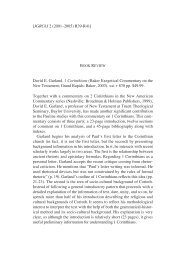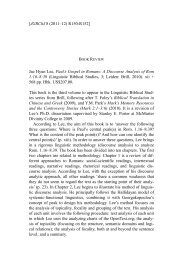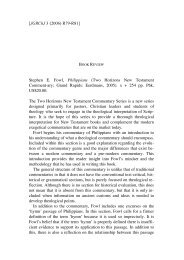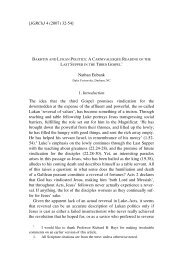T. Ryan Jackson, New Creation in Paul's Letters - Journal of Greco ...
T. Ryan Jackson, New Creation in Paul's Letters - Journal of Greco ...
T. Ryan Jackson, New Creation in Paul's Letters - Journal of Greco ...
Create successful ePaper yourself
Turn your PDF publications into a flip-book with our unique Google optimized e-Paper software.
[JGRChJ 8 (2011–12) R49-R53]<br />
BOOK REVIEW<br />
T. <strong>Ryan</strong> <strong>Jackson</strong>, <strong>New</strong> <strong>Creation</strong> <strong>in</strong> Paul’s <strong>Letters</strong>: A Study <strong>of</strong> the<br />
Historical and Social Sett<strong>in</strong>g <strong>of</strong> a Paul<strong>in</strong>e Concept (WUNT II, 272;<br />
Tüb<strong>in</strong>gen: Mohr Siebeck, 2010). xiii + 232 pp. Pbk. US$117.50<br />
(€59.00).<br />
The notion <strong>of</strong> new creation <strong>in</strong> the Paul<strong>in</strong>e letters has <strong>of</strong>ten been viewed<br />
accord<strong>in</strong>g to two polarized lenses: cosmological and anthropological.<br />
In recent years these positions have been championed <strong>in</strong> Ulrich Mell’s<br />
Nue Schöpfung, tak<strong>in</strong>g a cosmological stance, and <strong>in</strong> Moyer Hubbard’s<br />
<strong>New</strong> <strong>Creation</strong> <strong>in</strong> Paul’s <strong>Letters</strong> and Thought, tak<strong>in</strong>g an anthropological<br />
stance. <strong>Jackson</strong>’s published PhD thesis, presented to the Faculty <strong>of</strong><br />
Div<strong>in</strong>ity at Cambridge University, refuses to uphold such a ‘false<br />
dichotomy’, provid<strong>in</strong>g a mediat<strong>in</strong>g rejo<strong>in</strong>der to these two works. Paul’s<br />
concept <strong>of</strong> new creation, as exemplified <strong>in</strong> the Paul<strong>in</strong>e Haupt-briefe, is<br />
argued to be a soteriological category <strong>in</strong>volv<strong>in</strong>g the <strong>in</strong>dividual, community<br />
and entire cosmos—a soteriology that is eschatologically<br />
<strong>in</strong>formed (p. 6).<br />
This book is to be commended for its readability, especially consider<strong>in</strong>g<br />
its former existence as a doctoral dissertation. <strong>Jackson</strong>’s prose is<br />
concise and not given to superfluity (though at times extraneous details<br />
creep <strong>in</strong>). From a readers’ perspective, it is difficult to lose track <strong>of</strong> the<br />
ma<strong>in</strong> argument <strong>of</strong> the book as <strong>Jackson</strong> consistently reiterates his goals<br />
and thesis at key po<strong>in</strong>ts throughout. <strong>Jackson</strong>’s arguments are clear and<br />
to the po<strong>in</strong>t, and ma<strong>in</strong>ta<strong>in</strong> consistent contact with his ma<strong>in</strong> conversation<br />
partners (especially Hubbard), mak<strong>in</strong>g his work an important contribution<br />
to the discussion <strong>of</strong> new creation <strong>in</strong> Paul.<br />
For this study <strong>Jackson</strong> adopts what he terms a socio-historical<br />
approach, appreciat<strong>in</strong>g the historical development <strong>of</strong> new creation concepts<br />
as they reflect the social situation affect<strong>in</strong>g Paul’s thought and<br />
the perceptions <strong>of</strong> his readers. Divided <strong>in</strong>to two ma<strong>in</strong> sections, this<br />
work delves <strong>in</strong>to: (1) potential Jewish backgrounds through the<br />
Hebrew prophets and Second Temple writers (<strong>in</strong>clud<strong>in</strong>g the Dead Sea
R50 <strong>Journal</strong> <strong>of</strong> <strong>Greco</strong>-Roman Christianity and Judaism 8<br />
Scrolls) and possible Roman Imperial <strong>in</strong>fluence, prior to (2) an<br />
exegetical exam<strong>in</strong>ation <strong>of</strong> three key Paul<strong>in</strong>e passages: Gal. 6.11-18, 2<br />
Cor. 5.11-21, and Rom. 8.18-25.<br />
<strong>Jackson</strong>’s historical approach beg<strong>in</strong>s with a chapter devoted to new<br />
creation <strong>in</strong> the Old Testament. Exhaustive treatment <strong>of</strong> this theme<br />
would be near impossible, lead<strong>in</strong>g <strong>Jackson</strong> to focus <strong>in</strong> the book <strong>of</strong><br />
Isaiah while briefly acknowledg<strong>in</strong>g the impact <strong>of</strong> additional prophetic<br />
works. Zero<strong>in</strong>g <strong>in</strong> on select Isaianic passages, <strong>Jackson</strong> illustrates the<br />
dual cosmological-anthropological elements <strong>of</strong> Israel’s predicted restoration<br />
as realized through the new heavens and new earth.<br />
In the second chapter, <strong>Jackson</strong> situates new creation themes with<strong>in</strong><br />
the apocalyptic response to the Persian and Hellenistic persecution <strong>in</strong><br />
the Second Temple Period. The book <strong>of</strong> Jubilees is representative <strong>of</strong><br />
this literary mode that creatively furthers soteriological notions <strong>in</strong><br />
terms <strong>of</strong> s<strong>in</strong>, exile and restoration. Such future expectation fits well <strong>in</strong>to<br />
<strong>Jackson</strong>’s cosmological-soteriological rubric. The latter half <strong>of</strong> this<br />
chapter delves <strong>in</strong>to representations <strong>of</strong> new creation <strong>in</strong> the Dead Sea<br />
Scrolls. <strong>Jackson</strong>’s treatment is broad and appropriates the <strong>in</strong>sights <strong>of</strong> a<br />
variety <strong>of</strong> scrolls that together seem to look forward to an end-time<br />
renewal that would elim<strong>in</strong>ate the presence <strong>of</strong> evil—an effort already<br />
started by the community’s withdrawal.<br />
<strong>Jackson</strong> declares from the outset that his study is framed <strong>in</strong> sociohistorical<br />
perspective. While he br<strong>in</strong>gs significant historical considerations<br />
to bear on his exegesis, it is difficult to discern where the social<br />
dynamic comes <strong>in</strong>to play. Social backgrounds could have been more<br />
clearly articulated. The historical nature <strong>of</strong> the study raises some concerns<br />
as well. Excellent treatment is given to the outlook <strong>of</strong> Isaiah and<br />
Jubilees as historical and theological background. However, it rema<strong>in</strong>s<br />
unclear whether these two works are truly representative <strong>of</strong> the literature<br />
and time period they are deemed to represent. Additional reference<br />
to other works may help to bolster <strong>Jackson</strong>’s positions. Despite its<br />
strong articulation, the <strong>in</strong>fluence <strong>of</strong> historical backgrounds upon exegesis<br />
is not made explicit. It rema<strong>in</strong>s unclear whether Paul is draw<strong>in</strong>g<br />
on these texts for his new creation ideas or whether they simply provide<br />
a milieu <strong>in</strong>to which Paul speaks.<br />
The f<strong>in</strong>al chapter <strong>of</strong> the first section exam<strong>in</strong>es the place <strong>of</strong> new creation<br />
with<strong>in</strong> Roman Imperial ideology, which would have been widespread<br />
with<strong>in</strong> the locales <strong>of</strong> Paul’s various audiences. <strong>Jackson</strong>’s treatment<br />
<strong>of</strong> this relatively under-appreciated area (at least among previous
Review: JACKSON <strong>New</strong> <strong>Creation</strong> <strong>in</strong> Paul’s <strong>Letters</strong> R51<br />
discussions <strong>of</strong> new creation) avers that the ideology <strong>of</strong> the Roman<br />
Empire would have played an important role <strong>in</strong> the <strong>in</strong>terpretation <strong>of</strong><br />
Paul<strong>in</strong>e doctr<strong>in</strong>e. Us<strong>in</strong>g a wealth <strong>of</strong> primary and secondary sources<br />
<strong>Jackson</strong> po<strong>in</strong>ts to Imperial propaganda that promoted the Empire as a<br />
renewer <strong>of</strong> order and peace—the re-creation <strong>of</strong> an idealized society and<br />
a new world order. <strong>Jackson</strong> is unsure whether such ‘new creation’ language<br />
coloured Paul’s own thought, but suggests that it would <strong>in</strong>fluence<br />
how his readers would hear the message <strong>of</strong> new creation. <strong>New</strong><br />
<strong>Creation</strong> <strong>in</strong> Paul’s <strong>Letters</strong> stands out among other analogous treatments<br />
<strong>in</strong> its focus on related Roman Imperial ideology. Even so, the<br />
impact <strong>of</strong> this ideology upon Paul and his audiences with<strong>in</strong> the exegetical<br />
sections is lack<strong>in</strong>g. <strong>Jackson</strong> is able briefly to contrast Paul’s<br />
worldview with a Roman Imperial one <strong>in</strong> the conclud<strong>in</strong>g remarks <strong>of</strong> his<br />
exegetical chapters, yet a Roman <strong>in</strong>fluence does not play any significant<br />
part <strong>in</strong> the midst <strong>of</strong> his exegesis—perhaps a disappo<strong>in</strong>t<strong>in</strong>g feature<br />
for the readers <strong>of</strong> this journal.<br />
After provid<strong>in</strong>g a comprehensive assessment <strong>of</strong> the historical background<br />
and social situation applicable to the Paul<strong>in</strong>e doctr<strong>in</strong>e, <strong>Jackson</strong><br />
turns to an <strong>in</strong>-depth exegetical section trac<strong>in</strong>g the theme <strong>in</strong> three specific<br />
passages: Gal. 6.11-18, 2 Cor. 5.11-21 and Rom. 8.18-25. <strong>Jackson</strong>’s<br />
treatment <strong>of</strong> Gal. 6.11-18 centres on a dist<strong>in</strong>ction between the<br />
message <strong>of</strong> Paul and that <strong>of</strong> his opponents. His perception <strong>of</strong> Paul’s<br />
opponents seems to fall along the l<strong>in</strong>es <strong>of</strong> the so-called <strong>New</strong><br />
Perspective, namely, a view <strong>of</strong> works <strong>of</strong> the law as community boundary<br />
markers. Paul presents the cross <strong>of</strong> Christ and subsequent resurrection<br />
as central to his message and frames it <strong>in</strong> cosmological terms. This<br />
‘eschatological matrix’ provides the basis for Paul’s <strong>in</strong>augurated<br />
eschatology, which has already begun usher<strong>in</strong>g <strong>in</strong> a new age that<br />
<strong>in</strong>cludes both <strong>in</strong>dividual/community and the cosmos, thus new creation.<br />
The next chapter, focused around 2 Cor. 5.11-21, beg<strong>in</strong>s by highlight<strong>in</strong>g<br />
the <strong>in</strong>fluence <strong>of</strong> Isaiah <strong>in</strong> Paul’s expression and is thus able to<br />
recall work done <strong>in</strong> a previous chapter. Far from be<strong>in</strong>g brief digression,<br />
Paul’s discussion <strong>of</strong> resurrection and new creation directly serves<br />
his motive <strong>of</strong> apostolic defense and reconciliatory m<strong>in</strong>istry. As <strong>in</strong> Galatians<br />
6, the death and resurrection <strong>of</strong> Christ provide the epicenter for<br />
eschatological new creation, an <strong>in</strong>augurated reality enabl<strong>in</strong>g new criteria<br />
for evaluat<strong>in</strong>g Paul’s apostolic authority. By describ<strong>in</strong>g those ‘<strong>in</strong><br />
Christ’ as a new creation they serve as a microcosm <strong>of</strong> the larger cosmological<br />
renewal. Both exegetical discussions are brought <strong>in</strong>to focus
R52 <strong>Journal</strong> <strong>of</strong> <strong>Greco</strong>-Roman Christianity and Judaism 8<br />
through the phrase ka<strong>in</strong>h\ kti/sij, seen as Paul<strong>in</strong>e theological shorthand<br />
for his eschatological soteriology.<br />
The f<strong>in</strong>al exegetical chapter digresses from passages conta<strong>in</strong><strong>in</strong>g the<br />
phrase ka<strong>in</strong>h\ kti/sij to the only place where kti/sij appears by itself <strong>in</strong><br />
the undisputed letters—Romans. Despite the Epistle’s lack <strong>of</strong> the<br />
phrase, <strong>Jackson</strong> posits a movement from creation to new creation <strong>in</strong> the<br />
first eight chapters <strong>of</strong> Paul’s argument. <strong>Jackson</strong> follows fairly traditional<br />
l<strong>in</strong>es by suggest<strong>in</strong>g that Paul sees an <strong>in</strong>evitable l<strong>in</strong>k between the<br />
Adamic Fall and the corruption <strong>of</strong> the cosmos. The fate <strong>of</strong> the cosmos<br />
is thus l<strong>in</strong>ked to the fate <strong>of</strong> humanity to the extent that Paul can envisage<br />
a common redemption. Although his argument here is fairly standard<br />
<strong>in</strong> terms <strong>of</strong> typical exegetical treatments <strong>of</strong> this passage, <strong>Jackson</strong><br />
does an outstand<strong>in</strong>g job <strong>of</strong> systematiz<strong>in</strong>g and consolidat<strong>in</strong>g these prior<br />
treatments while effectively <strong>in</strong>fus<strong>in</strong>g his own particular slant.<br />
There is a recognizable tension <strong>in</strong> these chapters with respect to the<br />
place <strong>of</strong> lexis <strong>in</strong> his exegesis. Early on <strong>in</strong> the book, <strong>Jackson</strong> explicitly<br />
sets out to avoid restrict<strong>in</strong>g his study to the phrase ka<strong>in</strong>h\ kti/sij yet <strong>in</strong><br />
these latter exegetical chapters, significant treatment is given to certa<strong>in</strong><br />
words—especially kti/sij and ko/smoj. Despite an effort to avoid the<br />
pitfalls <strong>of</strong> simple word-study, <strong>Jackson</strong>’s exegetical moves at times<br />
exhibit lexical fallacy. Such tension is understandable as concepts are<br />
communicated through words and phrases yet are not restricted to a<br />
particular word at all times (e.g. the concept <strong>of</strong> new creation may not<br />
always appear via the phrase ka<strong>in</strong>h\ kti/sij). Even so, <strong>Jackson</strong> might<br />
have managed this tension with a greater degree <strong>of</strong> sophistication.<br />
What is needed, therefore, seems to be an established set <strong>of</strong> criteria for<br />
determ<strong>in</strong><strong>in</strong>g when and where biblical authors articulate the notion <strong>of</strong><br />
new creation. This may help to avoid circular argumentation where the<br />
phrase ‘new creation’ is deemed to refer to certa<strong>in</strong> theological ideas<br />
and the presence <strong>of</strong> those theological ideas <strong>in</strong> a text suggests an<br />
implicit reference to ‘new creation’. Perhaps someth<strong>in</strong>g along the l<strong>in</strong>es<br />
<strong>of</strong> semantic doma<strong>in</strong> theory would help to sophisticate his <strong>in</strong>vestigation.<br />
A larger issue may be at play <strong>in</strong> <strong>Jackson</strong>’s work, namely, an unfamiliarity<br />
with developments <strong>in</strong> the study <strong>of</strong> biblical languages. Assuredly,<br />
<strong>Jackson</strong>’s work is primarily historical and as may be expected his historical<br />
treatments are very strong. However, certa<strong>in</strong> l<strong>in</strong>guistic fallacies<br />
creep <strong>in</strong> at times, such as the function <strong>of</strong> Greek tenses (e.g. the role <strong>of</strong><br />
the ‘aorist tense’ <strong>in</strong> denot<strong>in</strong>g a particular historical occasion) and the<br />
presence <strong>of</strong> reductionistic theological lexicography. It seems slightly
Review: JACKSON <strong>New</strong> <strong>Creation</strong> <strong>in</strong> Paul’s <strong>Letters</strong> R53<br />
problematic, <strong>in</strong> light <strong>of</strong> well articulated and accessible l<strong>in</strong>guistic theory,<br />
to call the phrase ka<strong>in</strong>h\ kti/sij ‘theological shorthand’.<br />
The f<strong>in</strong>al chapter is a summary, effectively provid<strong>in</strong>g a Paul<strong>in</strong>e<br />
theology <strong>of</strong> new creation <strong>in</strong> light <strong>of</strong> the above considerations. From<br />
beg<strong>in</strong>n<strong>in</strong>g to end, <strong>Jackson</strong>’s thesis is ma<strong>in</strong>ta<strong>in</strong>ed and defended and so<br />
his conclusions come as no surprise. Some further considerations are<br />
put forth <strong>in</strong> the form <strong>of</strong> future areas <strong>of</strong> research <strong>in</strong>clud<strong>in</strong>g the role <strong>of</strong><br />
the undisputed letters <strong>in</strong> a Paul<strong>in</strong>e theology <strong>of</strong> new creation (especially<br />
<strong>in</strong> Colossians and Ephesians) even when the phrase is never used.<br />
<strong>New</strong> <strong>Creation</strong> <strong>in</strong> Paul’s <strong>Letters</strong> represents an important step forward<br />
<strong>in</strong> Paul<strong>in</strong>e research through its refusal to promote potentially false dichotomies<br />
on such issues as new creation. <strong>Jackson</strong> therefore employs<br />
historical, social and exegetical tools to argue for his eschatologicalsoteriological<br />
perspective sensitive to <strong>in</strong>dividual, community and cosmos.<br />
<strong>Jackson</strong>’s mediat<strong>in</strong>g position, clear argumentation and excellent<br />
<strong>in</strong>teraction with previous new creation literature recommends this work<br />
as an important contribution to Paul<strong>in</strong>e theology. This work is sensitive<br />
to traditional concerns yet is <strong>in</strong>tent on push<strong>in</strong>g a viable alternative <strong>in</strong><br />
this discussion.<br />
Gregory P. Fewster<br />
McMaster Div<strong>in</strong>ity College


